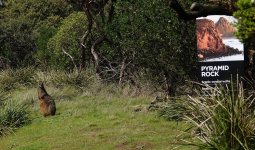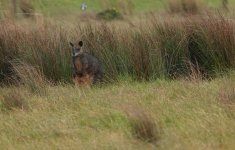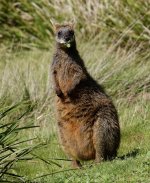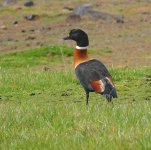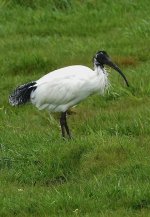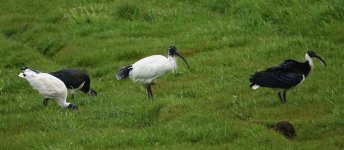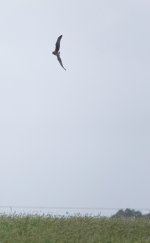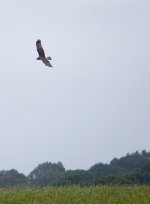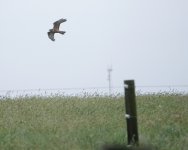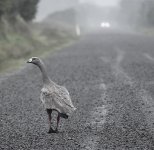MKinHK
Mike Kilburn

Conference Birding - Melbourne and Phillip Island
6 & 8 September 2023
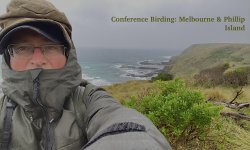
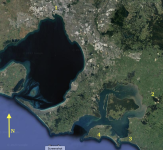
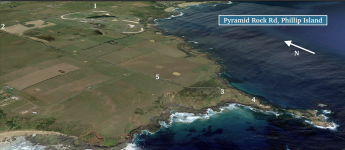
I'm absolutely delighted to be producing my first Conference Birding trip since a visit to Oakland in April 2020 just as COVID was starting to bite. The highlight of that trip was the five species of Geese that included Snow Goose, Ross's Goose and, best of the lot, Cackling Goose as lifers, the latter being my top bird of the year. I mention this because my principal target for this trip to Melbourne was the evocatively-named Cape Barren Goose, which is is best seen on windswept rainy headlands protruding into the Southern Ocean.
6 September: Albert Park
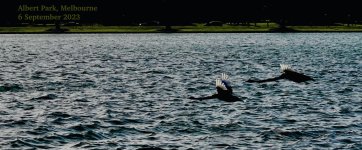
Coming from Sydney the main difference between Australia's two great cities is that Melbourne is WINDY!! Every time I stepped out of the hotel the wind, which has a sharply incisive chill, immediately reminded me I was far from home. One the first morning I went to Albert Park in the southern part of the city. It's set around a kilometre-long lake bordered by sports fields on all but the northeastern side. Unsurprisingly it was the waterbirds that dominated, with 100-odd Black Swans and 300+ Coot by far the commonest species. The Coot were important because my particular target because was a Black-tailed Native Hen that had been see foraging amongst them on the lawns three days previously. Despite covering the length of the lake and checking every flock I couldn't find it.
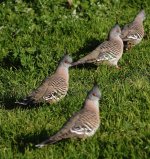
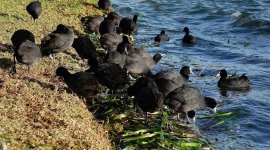
Other birds included Hoary-headed and Australasian Grebes, Chestnut Teals, Dusky Moorhens, Australian Swamphens and Spur-winged Plovers. Passerines were understandably keeping their heads down in the wind, but I did enjoy a quartet of Crested Pigeons foraging close-by on the grass.
8 September 2023: Pyramid Rock Road, Phillip Island
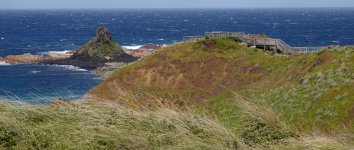
Having got to bed at 0330 following the post-conference after-party I was up at 0530 to make sure I was at Southern Cross Bus station at 0607 (1 on the small map)to catch the bus to Phillip Island. I had left it slightly late and ended up running into the bus station and made the bus with mere seconds to spare. The change at Kow Wee Rup (2) was seamless, and just under three hours after leaving Melbourne I got off the bus at the corner of the Grand Prix track (4 on the small map, 1 on the big map) in a light drizzle turned into flying misery by the 50kmh winds that whipped across from the west.
I managed to struggle into my waterproof trousers without falling over and headed westward into the teeth of the gale for the 90 minute walk to Pyramid Rock. I will be forever grateful to the friendly local, Lily, who took pity on me and very kindly gave me a lift down to the end of the road (3), thereby saving me a good 90 minutes' walk and significantly extending my birding time. Hopeful of finding some seabirds I headed straight down the boardwalk, now feeling the full brunt of the wind as it came straight off the sea. It looked It looked much more like the title pic than the one immediately above and I found nowhere sheltered to set up my scope so squatting on the final flight of stairs and trying to use my back as a windbreak (not recommended) I stared hopefully into the gloom. I did pick up a couple of Shy/White-capped Albatrosses, half a dozen Australian Cormorants and a dozen or so Greater Crested Terns through my wind-wobbled scope. Giving it up as a bad job I did winsome compensation in a fine pair of adult Pacific Gulls, drawing a fine line between beautiful and menacing with their monstrous yellow meat cleaver of a bill, and eight Black-faced Cormorants, whose range is restricted in mainland Australia to the coasts of the southern ocean.
Heading back inland I was absolutely blown away (ha ha) by a majestic Cape Barren Goose (5) in a grassy paddock right next to the road and helpfully close to a natural windbreak of denseleaved windswept trees in whose lee I was able to set up my scope and drink in this fabulous bird. While keeping a respectable distance of 30 metres or so it was wary, but not really scared of me and I thoroughly enjoyed the experience, which was amplified even more by the full force of the weather, which is best grasped from the video of this first bird in the field, and later on top of the tree where its mate is brooding . The geese were completely unfazed - and has clearly evolved to withstand exactly such conditions as these.
Thankfully the rain did clear, and as they sky turned from overcast to glorious sunshine the air took on that crystalline purity that only high winds and rain can create. it also brought out the curiosity of a bunch of young Angus cattle who wandered over to check me out and forcing the goose to take evasive action as they lumbered up to the fence.
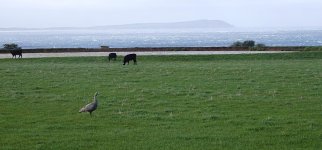
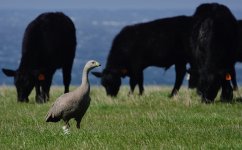
This clear weather coincided with my finding a family party with three humbug-striped goslings grazing close to the fence line providing the most wonderful views as they picked their way between the taller tufts. The parents stayed close at all times - and with good cause as a succession of raptors appeared. The first a white-rumped Swamp Harrier, then a couple of passes by a hefty Brown Falcon before even that was bettered by a fantastic Black Falcon that came right overhead, looking uniformly dark all over, and most crucially on the undersides of the wings and tail. Unfortunately it was far too fast for a picture, but looked slimmer and whippier than the more imposing Brown Falcon and undoubtedly topped the pops for the most unexpected bird of the day. Anyway, enough diversion - here's the Cape Barren Goose family:
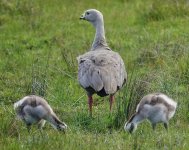
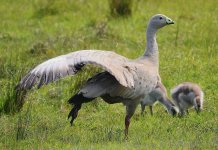
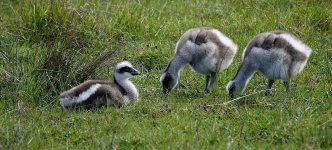
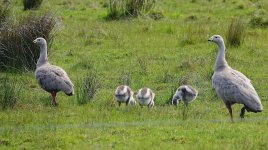
More to come ...
Cheers
Mike
6 & 8 September 2023



I'm absolutely delighted to be producing my first Conference Birding trip since a visit to Oakland in April 2020 just as COVID was starting to bite. The highlight of that trip was the five species of Geese that included Snow Goose, Ross's Goose and, best of the lot, Cackling Goose as lifers, the latter being my top bird of the year. I mention this because my principal target for this trip to Melbourne was the evocatively-named Cape Barren Goose, which is is best seen on windswept rainy headlands protruding into the Southern Ocean.
6 September: Albert Park

Coming from Sydney the main difference between Australia's two great cities is that Melbourne is WINDY!! Every time I stepped out of the hotel the wind, which has a sharply incisive chill, immediately reminded me I was far from home. One the first morning I went to Albert Park in the southern part of the city. It's set around a kilometre-long lake bordered by sports fields on all but the northeastern side. Unsurprisingly it was the waterbirds that dominated, with 100-odd Black Swans and 300+ Coot by far the commonest species. The Coot were important because my particular target because was a Black-tailed Native Hen that had been see foraging amongst them on the lawns three days previously. Despite covering the length of the lake and checking every flock I couldn't find it.


Other birds included Hoary-headed and Australasian Grebes, Chestnut Teals, Dusky Moorhens, Australian Swamphens and Spur-winged Plovers. Passerines were understandably keeping their heads down in the wind, but I did enjoy a quartet of Crested Pigeons foraging close-by on the grass.
8 September 2023: Pyramid Rock Road, Phillip Island

Having got to bed at 0330 following the post-conference after-party I was up at 0530 to make sure I was at Southern Cross Bus station at 0607 (1 on the small map)to catch the bus to Phillip Island. I had left it slightly late and ended up running into the bus station and made the bus with mere seconds to spare. The change at Kow Wee Rup (2) was seamless, and just under three hours after leaving Melbourne I got off the bus at the corner of the Grand Prix track (4 on the small map, 1 on the big map) in a light drizzle turned into flying misery by the 50kmh winds that whipped across from the west.
I managed to struggle into my waterproof trousers without falling over and headed westward into the teeth of the gale for the 90 minute walk to Pyramid Rock. I will be forever grateful to the friendly local, Lily, who took pity on me and very kindly gave me a lift down to the end of the road (3), thereby saving me a good 90 minutes' walk and significantly extending my birding time. Hopeful of finding some seabirds I headed straight down the boardwalk, now feeling the full brunt of the wind as it came straight off the sea. It looked It looked much more like the title pic than the one immediately above and I found nowhere sheltered to set up my scope so squatting on the final flight of stairs and trying to use my back as a windbreak (not recommended) I stared hopefully into the gloom. I did pick up a couple of Shy/White-capped Albatrosses, half a dozen Australian Cormorants and a dozen or so Greater Crested Terns through my wind-wobbled scope. Giving it up as a bad job I did winsome compensation in a fine pair of adult Pacific Gulls, drawing a fine line between beautiful and menacing with their monstrous yellow meat cleaver of a bill, and eight Black-faced Cormorants, whose range is restricted in mainland Australia to the coasts of the southern ocean.
Heading back inland I was absolutely blown away (ha ha) by a majestic Cape Barren Goose (5) in a grassy paddock right next to the road and helpfully close to a natural windbreak of denseleaved windswept trees in whose lee I was able to set up my scope and drink in this fabulous bird. While keeping a respectable distance of 30 metres or so it was wary, but not really scared of me and I thoroughly enjoyed the experience, which was amplified even more by the full force of the weather, which is best grasped from the video of this first bird in the field, and later on top of the tree where its mate is brooding . The geese were completely unfazed - and has clearly evolved to withstand exactly such conditions as these.
Thankfully the rain did clear, and as they sky turned from overcast to glorious sunshine the air took on that crystalline purity that only high winds and rain can create. it also brought out the curiosity of a bunch of young Angus cattle who wandered over to check me out and forcing the goose to take evasive action as they lumbered up to the fence.


This clear weather coincided with my finding a family party with three humbug-striped goslings grazing close to the fence line providing the most wonderful views as they picked their way between the taller tufts. The parents stayed close at all times - and with good cause as a succession of raptors appeared. The first a white-rumped Swamp Harrier, then a couple of passes by a hefty Brown Falcon before even that was bettered by a fantastic Black Falcon that came right overhead, looking uniformly dark all over, and most crucially on the undersides of the wings and tail. Unfortunately it was far too fast for a picture, but looked slimmer and whippier than the more imposing Brown Falcon and undoubtedly topped the pops for the most unexpected bird of the day. Anyway, enough diversion - here's the Cape Barren Goose family:




More to come ...
Cheers
Mike
Last edited:






